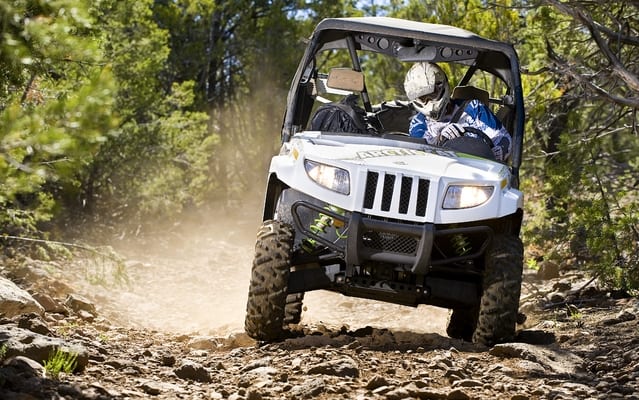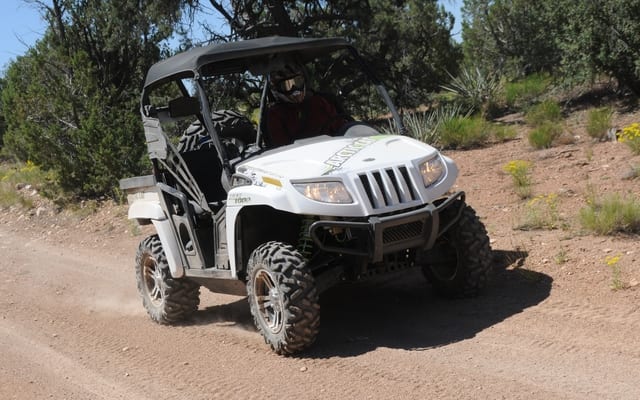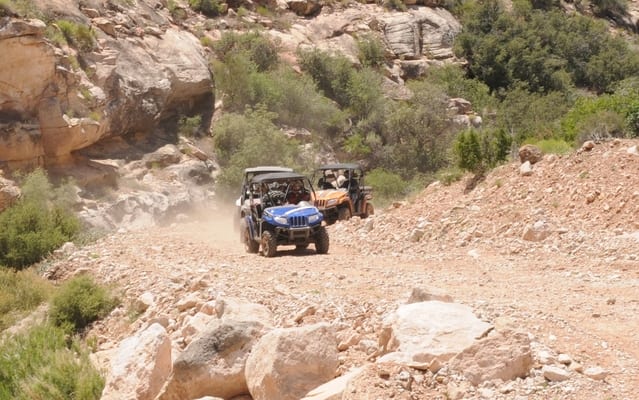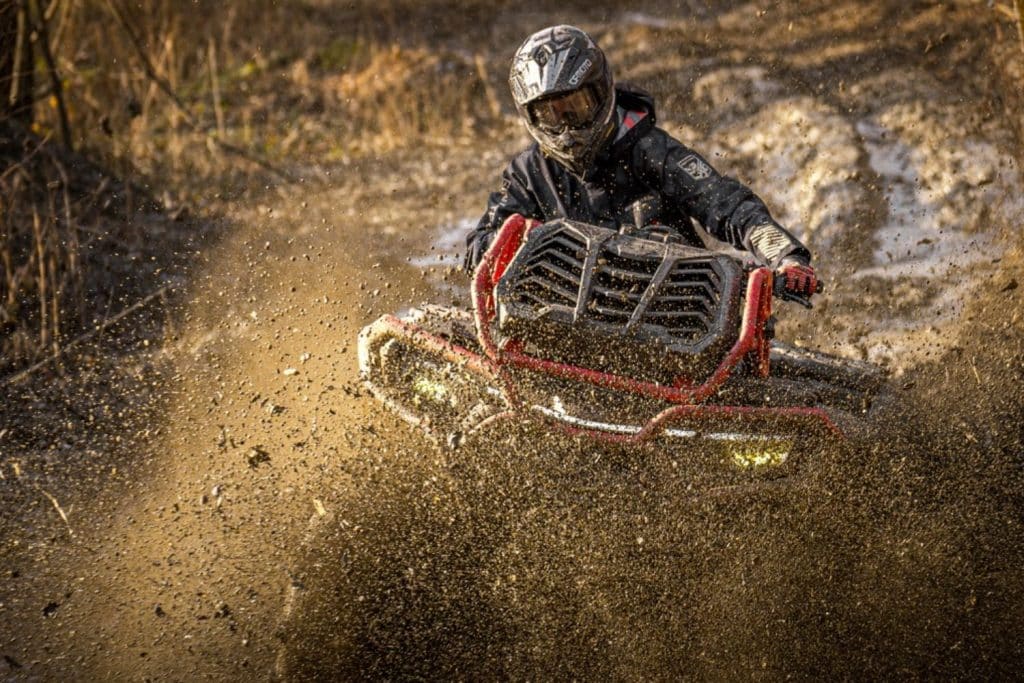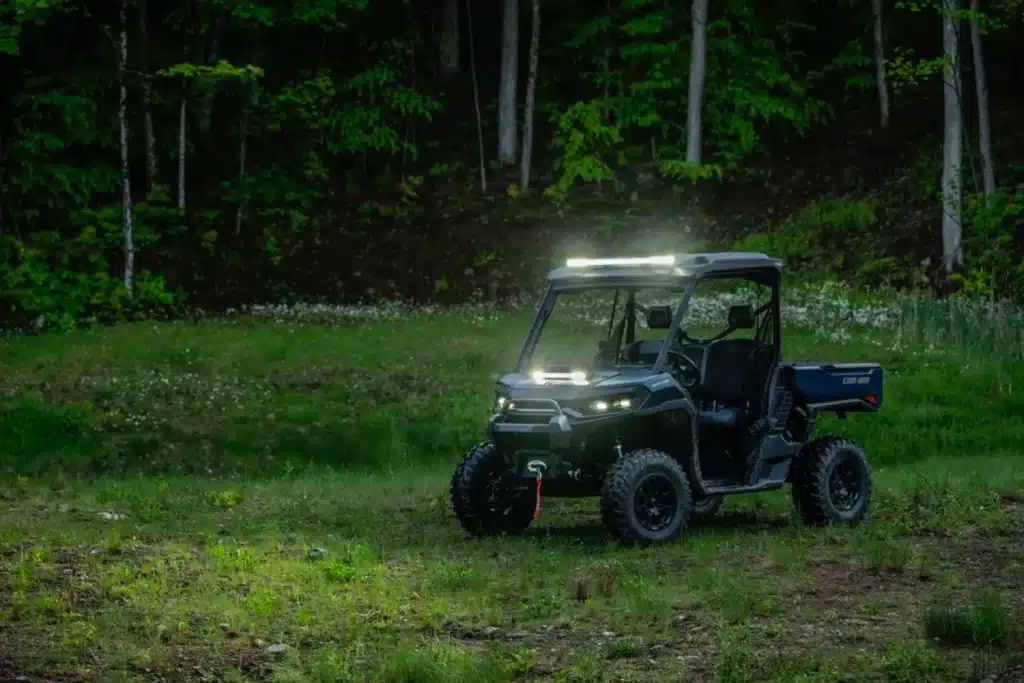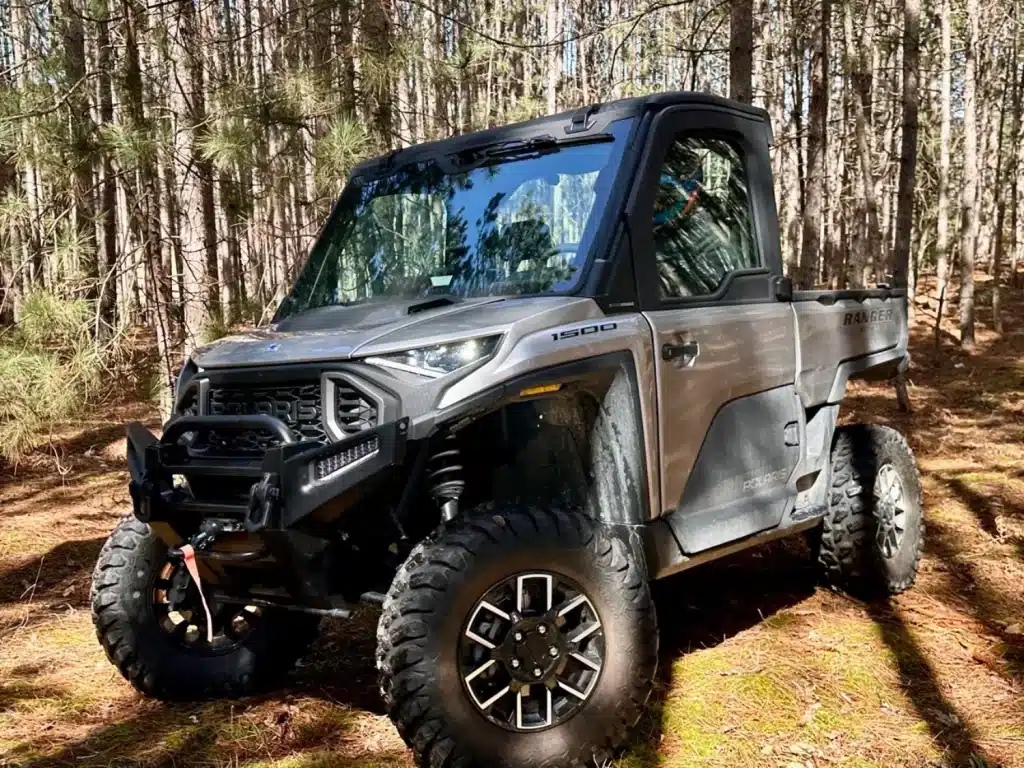The region’s varied climate and topography have given rise to a remarkable diversity of habitats and a correspondingly diverse array of plants and animals species. Its huge size and wide range of elevations and associated climates blend in perfect harmony to accommodate a large variety of animals who thrive and coexist. Desert animals have adapted to their environment, and each fills an important role in the desert ecosystem. We were still wondering if our Cats would fit in; would they show as much toughness to survive this very harsh region like Lynx Rufus? One thing was certain, the Arctic Cat people were showing amazing confidence in their Prowler products, to be leading us into such a long and challenging trip, out there, alone in the middle of nowhere.
There we were, all 16 Arctic Cat Prowler UTV’s glaringly clean for the time being, and they looked really nice with their new Baja racing-inspired, ROPS-certified round tube canopies replacing the old Prowler’s boxy looking cage and cool new sporty colour schemes. The unevenness in terrain was still only at stretched eyes reach in the distance, as we travelled just a few clicks on the dustless and noticeably perfect asphalt. Our starting point was the Casablanca resort and Casino parking lot in Mesquite, a half-hour drive from Vegas. Despite having fully understood the very serious and logical security speech, given by our newly found and fond friend/guide Wally, from SideXSide Outfitterz, my rear wheels hit the very first speck of dust, already spinning. If I was to get to know this buggy, I needed to get an early feel for what it had to offer power wise. I smiled despite the fact that my teeth were getting sand blasted by Joey in his XTZ 1000 in front of me. Keeping a good distance would be the trick pretty much all the way to our destination, but filtering that dust out is crucial during such long treks through the desert. A simple bandana did a good enough job for me, and wetting it from time to time not only helps catch dust better but it also helps keep you cool.
The opportunity to get a good feel for the buggy’s responses and behavior with the maximum grip of hot pavement had been short but telling and I had just dared to grind those soft wide and curved threads on the Prowler 700 XTX’s Duro tires. I liked the when and where the suspension was trying to stop the rolling effect, staying seemingly smooth and not fully compressed so to keep a gradual feel of what was happening with the whole package, at all instants, during this very un-recommended sort of move on a UTV. No surprises with this one, despite a clearly detectable small amount of over steer, which made driving this ride amazingly fun once on looser grounds.
Some animals survive only in the Mojave Desert, these are called endemic species. Others are merely passing through on a migratory path and some live throughout all the southwestern desert areas. Regardless, whether living permanently in the Mojave, flying over it or by staying only seasonally, adaptations to the extreme climate and lack of water must be made. Our solution to this challenge was to pack a whole lot of cool water and other non-alcoholic drinks, plenty of snacks, and an assortment of practical things such as tire plugs and lots of spare tires, basic tools, and a decent amount of confidence in our expert guide Wally. The soft tops were an absolute must to shield us from a powerful desert sun.
The knowledge that another type of feline could also be travelling along these trails or crossing them, or that snakes could be lurking by too, kept everyone alert at every stop for a water break. The largely carnivorous Lynx rufus (otherwise known as a Bobcat), eats various lagomorphs, rodents, a few deers (mostly young fawns), some birds, reptiles, amphibians, and invertebrates, which we almost all caught a view of at some point. The bobcat is apparently capable of existing for long periods without drinking water. I was hoping they could go without eating for a long time as well. I couldn’t say as much, it was so hot that I was constantly reaching for my drink in the practical cup holders pleasantly placed, and really appreciating the small drop-in rubber netted compartment just in front of it, to hold snacks and other trinkets. I also had a glove box at my disposal.
Puma concolor, the mighty Mountain Lion, can be spotted from sea level to alpine meadows, in nearly all habitats, except xeric regions of the Mojave and Colorado deserts, which do not support mule deer populations. Recent studies by the California Department of Fish and Game, suggest that 2500-5000 or more mountain lions currently live in California, and the numbers appear to be increasing. So far, my Cat, a very cool flashy green Prowler XTX700, was eating up everything the region had to throw at it. Its menu was far less diversified though, including infinite supply of rocks, bigger ones, and some pointy ones that my DURO tire equipped XTX had trouble digesting.
After 150 miles, 2 flat tires, a killer tasting tailgate lunch and the most awesome trailing and scenery I had ever experienced, we finally reached our first destination: the Bar 10 Ranch, a working cattle ranch located nine miles from the north rim of the Grand Canyon, right in the middle of one of the most remote areas of the western United States. The Heaton family has been ranching on the Arizona Strip for five générations. Access to the ranch house was simplified by adding an airstrip to the property, at about the same time tourists began running the Colorado River in rubber rafts. Tony and his four young sons were soon bringing wet, sunburned, awestruck tourists up from the river to his ranch, using teams of mules. The mules were soon replaced by an old bus and their dirt air strip was gaining popularity. In the mid 1970’s, the Heaton’s efforts ferried only 125 people, but by 1983 they were seeing 1,000 people per summer. In 1985, the Heaton family set aside the mules, in favor of helicopters and quickly saw the numbers of visitors to the Bar 10 Ranch increase to 6,000 per season.
Country hospitality was quickly and obviously displayed by the very first few cowboys we had the pleasure of shaking hands with and returning a smile to. Their overly friendly dogs, walking up to each of us in succession, despite the proximity of our big, dirty and dusty Cats, were demanding lovingly strokes through their semi-clean fur, as if we were all part of the same big family. Also tasty, was the announcement that dinner was served, at the ring and ding of the traditional metal triangle. Even tastier was the traditional meal itself. Conestoga Wagons are offered as additional, private sleeping quarters, but seemed to be very popular with guests for their comfort. I chose the other cool option of just sleeping under the stars on a huge deck atop the main lodge. Boy, was I glad I chose this option; first of all because lizards, big spiders and small snakes seemed to also finds those wagons comfortable, and secondly because that first night I saw the most awesome light show I had ever seen in my entire life! Not just a lot of stars, clouds and clusters of them. I actually managed to shoot the Milky Way and get, you guys, a decent photo of it. It kept me up almost all night.
Unmatched throughout the world for the vistas it offers its visitors, Grand Canyon National Park spans nearly 8,000 ft. in elevation, from the Mohave desert scrub regions along the Colorado River in the park’s western end, to the Kaibab Plateau’s subalpine conifer forests on the North Rim. The result is the existence of three broad wildlife habitats: the Colorado River corridor and inner canyon riparian areas (Riparian), inner canyon desert uplands (Desert Scrub), and the coniferous forests (Coniferous Forest). The desert might seem to have little in the way of wildlife, but it actually contains large and diverse populations.
Some might choose to take the available thirty-minute scenic helicopter flight from Las Vegas, Nevada to get to this historically rich and pleasant Ranch. I, for one, rather enjoyed our solution for discovering the area to its fullest. Those Cats were clawing up like true beasts and rolling down smoothly to attack the next challenge with assurance, all day long. I would repeat the rock crawling up endless cliff edge trails, slightly power sliding out of turns of every type imaginable, and getting a little more technical in various types of valley trails, sometimes with trees to very logically speed by, or massively impressive rock formations that prompt a stop for a few amazing photos, any time! Why would anyone want to fly over all of this Grand adventure? One can only truly appreciate the remoteness by standing on firm ground, or sitting in a smooth riding Prowler.
My Cat had healthily purred when calm and growled when asked to, all day long.
No problems whatsoever expected for the tires, which were fine in behavior but not very well-suited for so many pointy rocks. The walls on those tires, contrary to the Maxxis Bighorns on the XTZ 1000, are bare of any threads and that is where I got punctures both times. They also have a lot more bare rubber throughout the entire pattern. On smoother parts of our trails though, I thoroughly enjoyed what the slight over steer feels and what free to slide type of thread did to the buggy. Power sliding was actually doable without any power at all, and a small but decisive jerk on the steering under braking was enough to position the car into a slide, even at as low as 25 km/h. Don’t get me wrong though, some might find this to sound scary, but it is the total opposite. The ride actually communicates better with the rider this way, sort of warning to slow or sometimes even to gas up, in a gradual fashion. Predictability is a great trait for such a vehicle and this one had a good amount of it. I would later find the XTZ 1000 to not be as forgiving, with a very different tire and suspension package, and a power output needing a bit of experience.
Among my favorite good things about our Cats is the soft steering, which endlessly bends in your hands and takes out a very large amount of any sort of impact. Incredibly enough, this simple idea of making the steering wheel out of a flexible and sturdy memory plastic makes a huge difference out here in such rough and challenging conditions. Can’t help but think that the same sort of principles could be applied to seat mounts, to give just a tiny bit of suspension to them.
The XTZ 1000 comes with the much tougher Maxxis Bighorns and those really stood up to those sharp rocks. The suspension is also quite different and a little better on this one, with larger Ryde FX units that really worked well. The fuel-injected 950cc v-twin hemi- powering it puts down some serious torque, and the all-in-one 2WD/4WD/Diff Lock rocker switch button was great for quick engagement shifting, which I needed and used quite a few times during our adventure. I truly felt this stronger Prowler to be the good choice for more intense and particularly tough trails. The Bighorns permitted non-hesitant moves and the occasional rub underneath felt like a joke to this beast. The Ryde FX units are much larger and the top pivot is anchored way higher than on the 700, so bottoming out was close to impossible. On flatter grounds, my tad aggressive driving didn’t feel unsafe at all, as I wasn’t letting my ride pick-up too much speed, but rather unleashing its torque generous power at every exit out of a turn. Still, the rear end had a little more grip to it and kind of scared me on one occasion. Wow, talk about fun in the sun! I was hoping to keep it for the rest of the day, but I, of course, wasn’t the only one with a taste for such a sporty ride and politely accepted the switch with a media fellow, hiding my pouting under my helmet.
All new for 2011 is the Arctic Cat Prowler HDX 700 side-by-side, and we were equipped with a few units of those also, which pretty much served as mules for the entire convoy. They were the only ones in the group packed with heavy filled to the rim coolers, spare tires and wheels and jerry cans. The 40/20/40 sculpted seat that can carry three adults was almost as comfortable as what I had experienced in my by now beloved green XTX 700 Cat. The HDX 700 has also been equipped with Arctic Cat’s new Variable Assist Electronic Power Steering (EPS) system, along with a five-position tilt steering column. As far as I was concerned, I wouldn’t need the assistance, as all Prowlers are surprisingly easy to steer without any assistance. Keeping in mind that this particular ride was designed for lots of quick in and out and tight turn around maneuvers, this added feature should be a very welcomed one. One would surely come to love it, if often using the 4WD and differential lock. Another very interesting feature on this particular model is its Fox FLOAT Air Assist shocks with coil-over springs. For increased load capability, the vehicle’s load requirement can be easily adjusted, by simply adding air pressure to the FLOAT air chamber. The fully independent double A-arm front and rear suspension system offers 10 inches of travel and 10 inches of ground clearance. Like our other Prowlers.
Ancient rocks are beautifully polished and sculpted by the awesomely patient waters that once passed over. Most times into odd shapes, but sometimes looking like familiar things. Preserved and exposed in the walls of the canyon forever. As I enjoyed the magnetic feeling of being pulled towards this beautifully grand void in the earth, sitting there calmly, I was overwhelmed. OK! Enough of this, let’s get in those Prowlers and head back home before I never want to leave this beautiful place again. Those Prowlers performed like Mountain Lions, as they all brought us back to Mesquite safe and sound, and on schedule. Thanks Arctic Cat! Now I feel like I could explore any place on earth in confidence!
For more information on the above mentioned models, please visit the Arctic Cat Website
More from Arctic Cat on ATV Trail Rider :
Arctic Cat ATV Models – Arctic Cat UTV Models – Arctic Cat ATV Reviews – Arctic Cat UTV Reviews


